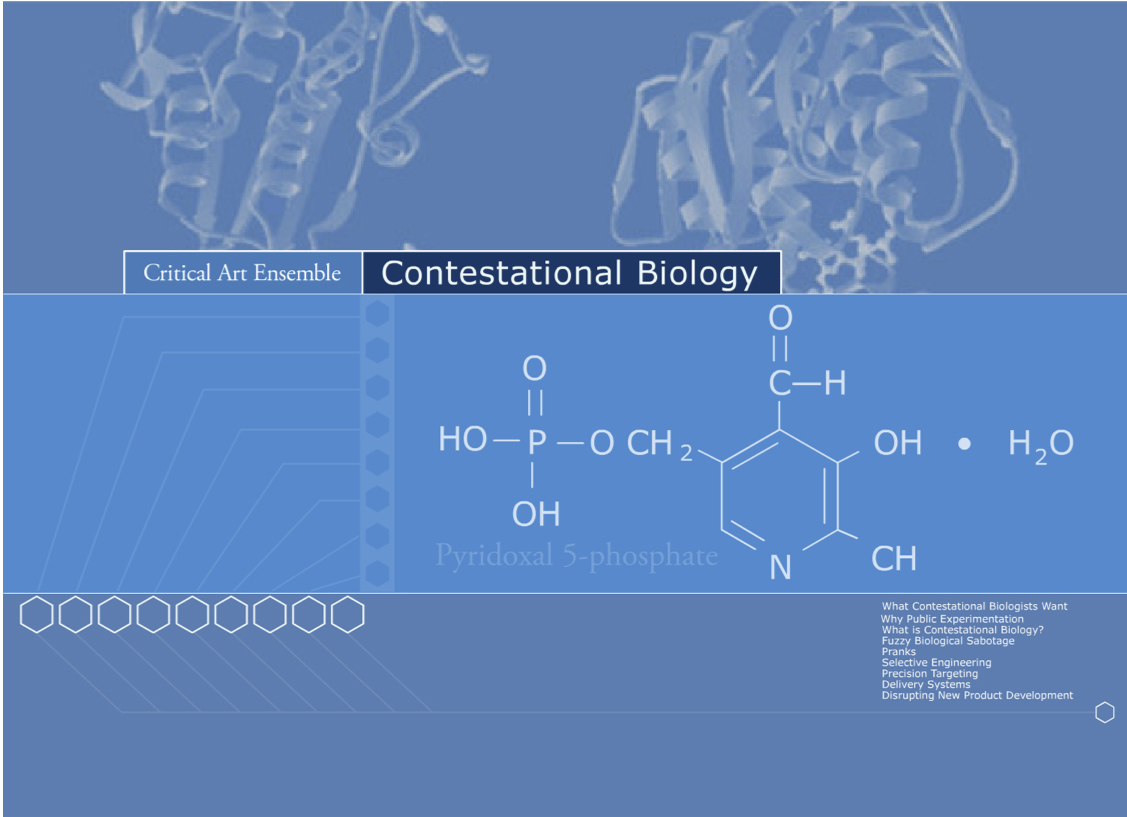
Contestational Biology. Critical Art Ensemble.
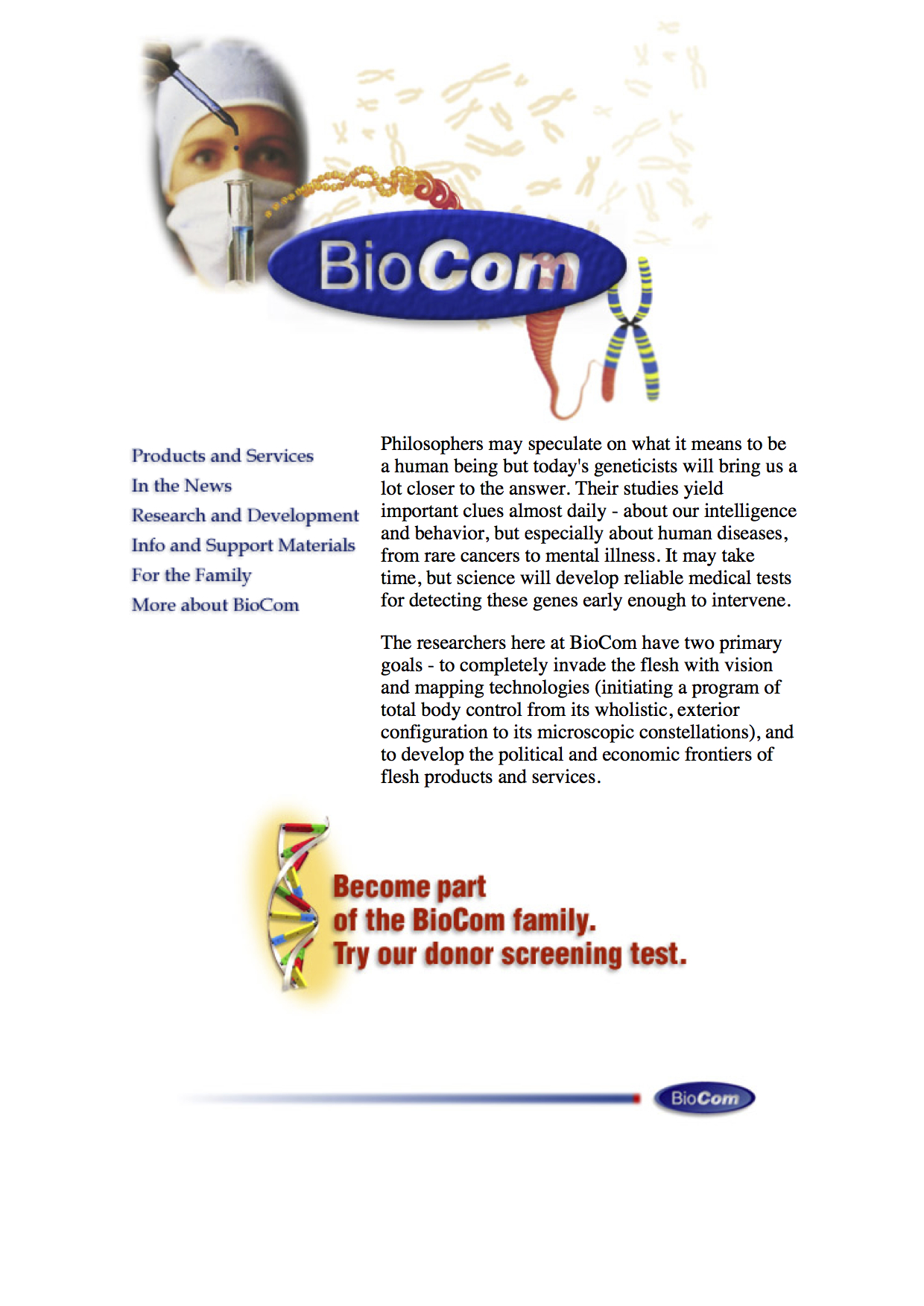 BioCom. Critical Art Ensemble. BioCom. Critical Art Ensemble.
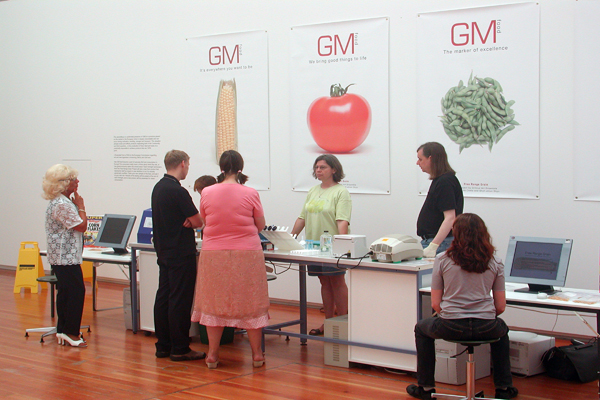
Free Grain Range. Critical Art Ensemble.
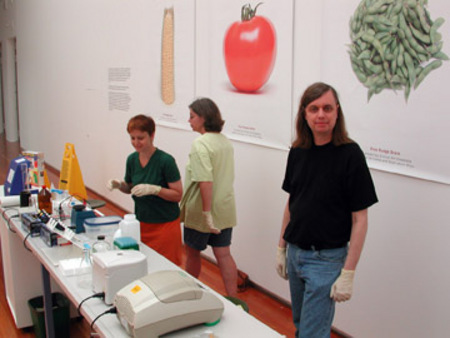
Free Grain Range, Steve Kurtz. Critical Art Ensemble.
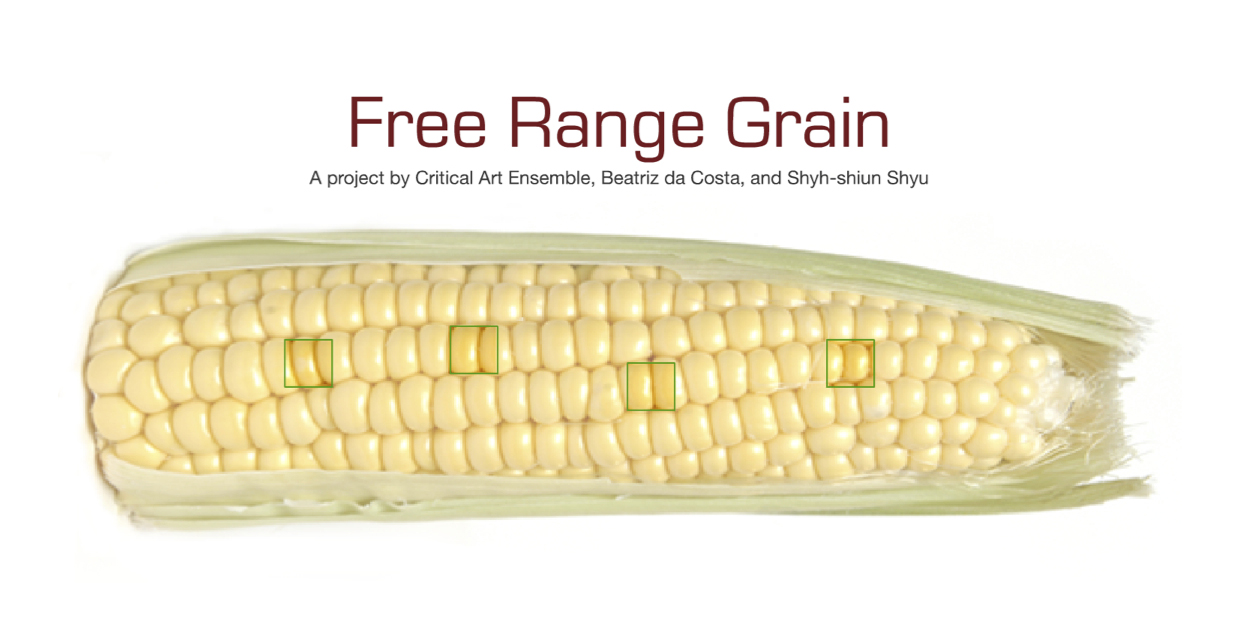 Free Range Grain. Critical Art Ensemble. Free Range Grain. Critical Art Ensemble.
All photos from: Critical Art Ensemble.
|
»An Aesthetics of Disorganization as Contestational Strategy«*
Laura Benítez Valero
In recent years, the transdisciplinary relationships between Art, Science and New Technologies have led to the generation of hybrid contexts that, not only have provided new conceptual framework for theory and art criticism, but have also led to paradigm shifts affecting other areas of knowledge. Therefore, my proposal focuses on taking these transdisciplinary relationships as a starting point for the research and development of critical theoretical models of contemporary art and culture.
This proposal of research starts from the findings of my doctoral research, presented as a doctoral dissertation entitled Bioart. An Aesthetics of Disorganization[1] . My goal here is to explain why the artistic practices included under the term Bioart not only provide a place for philosophical thought, but have become a philosophical exercise and, therefore, an exercise of critical thinking. The term Bioart includes not only artistic practices using non-human living organisms, but also covers those practices using technology to manipulate living organisms (Biotech Art), and practices that work with modified organism through genetic engineering (Transgenic Art). They also are contained, along with Bioart, within the term Genetic Art, which designates artistic practices involving DNA and genetic engineering in different media and devices. This theory of sets of terminology relating to Bioart, I would add one more set, the Hybrid Art, which would be the general framework.
For the work that concerns us here, I will use the term Bioart referring to those artistic practices that work with biotechnology as a media, as well as working semi-living, living, or systems and genetic engineering. Therefore, whenever the term Bioart is used in this article, the terms of Biotech Art, Transgenic Art and Art Genetic are implied, with reference to the term Hybrid Art as a general conceptual framework.
The first objective to demonstrate this, has been to show how the so-called Bioart offers a substantial change in the relationship between art, science and new technologies, especially between art and biology. This type of artistic practices represent a paradigm shift in the relationship between art and life, because life is not represented but presented, and amended by means of biotechnologies. Hence, this artistic proposals invite us to forget the contemplative relationship persisting in the context of contemporary biology, achieving an interactive relationship instead.
This project also provides an introduction to the debate on artistic research. There has been a heated controversy on the question about what they mean with the concept of artistic research. Due to the different lines of discussion around the issue of research in the context of the arts, I feel obliged to clarify the meaning of artistic research I am referring to. This clarification intends to avoid falling into relativism. Therefore, when I refer to artistic research I am taking the artistic research concept of what Henk Borgdorff called research in the arts[2] , a type of research that does not establish a separation between object and subject, and consequently, does not consider a distance between the researcher and the artistic practice. In the contemporary context, art or artistic practices no longer play the role of an object of study. In fact, many contemporary artistic practices are potentially philosophical, namely, the artistic practices have become a philosophical exercise. Thus, I propose to define Bioart practices as art-practices-as-research, inasmuch as I understand that the main purpose of these art practices is to provide new knowledge out of original research, both from artistic objects as from creative processes. Bioart includes, mostly, artistic projects in which research is a set of inclusive processes, transverse rather than homogenizers. These practices build spaces for participation where the binary division between art and science is disrupted, revealing, through the use of biotechnology as means of art, that this two areas are complementary and in what concerns knowledge development their relationship is symbiotic. While science informs about life, Bioart projects expose the problems of this information. These projects become a tangible example of how scientific research may be relevant to the artistic research and viceversa, both one and the other are necessary to develop critical theoretical models of contemporary art and culture.
Bioart proposes a direct interaction with the artifacts and speeches of the scientific realm but experimenting with them and evaluating them from an artistic practice. Artifacts and hybrid discourses demonstrate the social impact of both (art and science). These projects provide the possibility of interacting in the presentation of contemporary ethical problematic through the challenge of pressing the audience to face the need of an ethical positioning in the artistic context. In this way, the transfiguration of scientific technologies to the artistic field disrupting common uses and hegemonic narratives, build spaces of participation where the potential ethical-political issues derived from the use of these technologies are discussed, becoming a learning process. Accordingly, when we are confronted with artistic practices that imply learning from the aesthetic experience, a space where we can learn us, art becomes a place for knowledge. This knowledge is transversal, which means we are digging in the present problematic concerning art and culture thanks to the commitment to a collective critical discourse. These pieces subvert truth building, standardisation and normalisation processes. This does not mean the banishment of all standards, but the possibility to evidence the dynamic character of the norm through the aesthetic experience.
I have addressed particularly the relationship between biotechnology, bioethics and biopolitics through the work of the collective Critical Art Ensemble (CAE). Free Range Grain, as much as the texts of the mentioned collective, represents a commitment to biology as a contestational weapon to denounce political misuses and abuses concerning the possibilities of biotechnology and its applications in the context of the everyday.
Critical Art Ensemble is critically positioned towards the political and economic uses of biotechnology. Their proposals are strategical and are forms of protest. Claiming the need for spaces of resistance(s) in the neoliberal context is one of the hallmarks of the group, that outline their works adopting the cultural practices of resistance, through installations and participatory performances, challenging representations, products and policies related to biotechnology. However, this critical positioning, must be performed from both the access to biotechnology techniques and through the narratives that accompany them. Their participatory performances rely on the possibility of a public debate about biotechnology where there is room for both specialists and non-experts or amateurs. Although CAE, in his book Molecular Invasion[3] , proposed a contestational biology, I refer to it like biotechnology as rebellious weapon, taking a look at the control of societies of Deleuze, understanding the need for new weapons, and the conception of biotechnologies as a series of practices pertaining to contemporary biology used for all kind of artistic practices, not just those made by CAE.
In Molecular Invasion, the group proposes a theoretical and tactical route to perform an appropriation of the Biology as vehicle of rebellious strategies and transgenics are one of the great protagonists. Although, unlike the vast majority, CAE do not approach the issue of genetically modified organisms (GMOs) biopolitical realm of representation, but opt for a direct interaction with them that allows to evaluate the mechanisms of production and its social reception. An interaction that provides spaces to counteract the information that corporations producers and research institutions present about this type of genetically modified organisms.
On the other hand, because GMOs represent a highly controversial and complex issue, which as of today is still full of gaps and conflicted positions, CAE also committed to the demystification of the fear of monsters, hybrids, modified, or impures, and warns of the danger this fear contains: to fall into the re-affirmation of life-sacralising narratives. Therefore, and despite they have been constantly asked about their positioning, CAE recognizes they do not have the tools to position themselves in absolute terms as in favour or contrary to GM, as there are issues rendering them as abominable, with serious consequences for the environment, while regarding others their properties seem desirable and with no apparent drastic consequences for the environment.
One of the reasons why CAE devotes a large part of their work to the issue of GM is the interest of the collective in analysing representations of GM and the great contradictions they are exposed to. In a similar way the collective refers to the espectacles of fear, and connected to this term, CAE refers to the world of representations as the spectacles of transgenics, which encompasses a market that, being a market, try to get the maximum benefit, claiming that promoting genetically modified organisms the free market works for the good of public interests, such as environment or health. This almost utopian representation of the benefits of GM clashes with the radical opponents to these products, since they consider this genetic intervention in nature a recklessness that could lead to very high, or even catastrophic, costs. In spite of divergences, the absence of long-term studies and the good publicity of GM, considering genetic modification as something that could only provide benefits does not seem to be very effective as society is concerned, as the majority of the population is reluctant to this type of production. In fact, almost every country in the European Union have completely banned the cultivation of GMOs in their territory, although not its import.
CAEs will to generate a critical public discourse about GM also comes from the suspicion that the results and applications of research projects on genetically modified organisms will rarely be publicly available. This suspicion, as a statement of the collective, comes from the belief that the pan-capitalist policies, where the boundaries between development and underdevelopment are blurred and coexist, only want to increase the benefits of the machine, the meat machine. The market of biotechnologies belongs to it as is subjected to the political uses of neoliberal market and could only be designed to produce new consumer goods, new commercial spaces seeking the maximum financial return, meaning serving the public would be a matter of last resort. It is because of this political-commercial use of biotechnologies that CAE refers to this state of the expansion of modified organisms as the molecular invasion, an invasion where these exploitations transform control in new forms of endocolonization and colonization. But it is in alimentation where the issue of genetically modified organisms has more impact, from farming to processed foods: "The focus seems to be on consolidating the food chain from molecular structure to product packaging. With the ability to better control species expression, corporations have a better chance than ever to intensify developing nations' dependency on western corporate economy. Food must either be purchased from corporate food suppliers, or the necessary organic and chemical materials must be purchased. Either way, resource management is controlled by western capital. Farmers can be leveraged either to grow cash crops like cotton or any combination that is most advantageous to the colonizer. This plan has existed since the inception of industrial farming, so food resource hegemonies have simply been given another powerful tool that fits perfectly into the current structure of domination."[4]
Biotechnology becomes essential for this domain of food industry where productions can be privatized, since biological material based work and the genetic modification of them for economic purposes means the processes and outcomes are likely to be patented. The resources of biotechnologies provide an opportunity to intervene a seed, for example, creating a modification that lends to it some specific properties by which it can be patented. This is undoubtedly one of the more controversial lines in the transgenics debate, the possibility of dividing different micro-properties of a plant, so that each of them bears a patent and its use without payment of property rights can result in a substantial penalty.
Accordingly, CAE proposes that an issue that affects us all in the short or long term, and from which we are kept in a constant state of disinformation due to corporate interests and political manipulation, deserves an answer. This answer lies in the development of a specific attack aiming directly to cause struggle in the benefits generated by the neoliberal management of genetically modified organisms, a response through interaction, an attack from a contestational biology:
The answer is as singular as the pancapitalism machine itself - disturbing the profit flows. Certainly, the use of traditional and electronic methods of contestation will be useful, but how can the new molecular/ biochemical front be directly engaged as a mean to disrupt profits? Two inmediates hurdles that must be clarified are the connection of bioresistance to violence and the tendency of resistance to be urban-based. Given that living organisms are of concern, it is quite likely that introducing inertia into the profit system will damage genetically modified life. Industrial culture has had the environment under fire for decades (and in some areas for as long as two centuries), so CAE is only proposing returning fire. Furthermore, the rules of engagement are pretty well established. If one assumes that bioresistance should use violent methods only as a last resort, and only as to the extent necessary to be effective, a number of possibilities that will not lead to jail time present themselves. Corporate culture has long maintained that violence through secondary consequences is not the fault of an individual agent of institution. For example, if a manufacturing process causes acid rain, the manufacturers are not responsible for any ill effects on flora, fauna, or other environmental elements, nor are they responsible for any type of clean-up. If the resistance can locate itself in the same fuzzy field, legal counter fire is possible that would be disturbing and effective.[5]
The group seeks the spaces of resistance(s) that occur within the frameworks of power of the biotechnology industry, seizing the resources of it to deconstruct their corporatist precepts. A performative resistance that seeks to unveil the role played by the relations of power in these political uses of biotechnology, with the intention of revealing the power that lies behind them. But this performative proposal does not reside in improvisation, but in the configuration of a tactic and effective cultural bioresistence. In order to develope such resistance the group propose strategies to carry out seven key points: demystifying transgenic products and production, neutralizing the public fear, encouraging critical thinking, undermine and attack the utopian rhetoric, open the halls of science, dissolve the cultural boundaries of specialisation and build respect towards amateurism.
The contestational artistic practices of the group intends the demystification of GM in order to open spaces for critical reflection, neutralising in this way the fear generated by different biopolitical constructs that result in collective bioparanoia. The key to neutralize fear is having access to information, but this is an arduous task in a realm dominated by patents. To accomplish this demystification of GM processes and production, rebellious practices built spaces of accessible information. They provide information about the nature of biotechnology initiatives, hidden behind a screen of the rhetoric of benevolence and demonstrate the need to know thoroughly the origin, the context and purpose of biotechnological processes so they can also offset positions that are categorically opposed to any use of biotechnologies, as in some hard lines of the so-called «deep ecology», which could lead to moralistic and reactionary approaches. Since society does not normally have access to laboratories, the relational experience with GM beings is denied and thus they can not interact. Not knowing what we are facing, and what kind of research is being carried out, means maintaining the non-scientific population in a sort of ignorance that breeds insecurity, a feeling that can only be confronted by his contrary, safety, since the other "the hidden one" genetically modified, can be a threat, or serve to perpetuate the attack of an invisible enemy, as the abused body construct rightly advise, and could even be used for terrorist purposes.
The ignorance in most of the population about the possibilities of biotechnology and especially on the political uses of it, serves as a guarantee for the system, since if the whole society has a limited knowledge of GMOs, for instance, the expertise provided by tactics that only underline their benevolence, then the control task is considerably easier, a more comfortable management of restrained bodies. Such an ignorance creates biopolitical narratives of security, through which the message that the State is the only one who will make good use of biotechnological applications is sent. But precisely because of the potential of these techniques we must remain vigilant and not let them fall into groups of dubious moral intentions.
CAE's proposal is to replace the Edenic rhetorical by a critique of political systems and applications that allow us to demonstrate the relations between individuals and biopolitics authority(ies); thus identifying education and the access to information as fundamental pillars of the practices of liberty versus security as repression. The keypoint of the bioresistence cultural practices proposed by Critical Art Ensemble is the creation of public spaces for exchange between education and all kinds of inter-sub-cultural practices, a space to dissolve the barriers of specialization. This dissolution involves the commitment to interaction and also the refusal to grant such power to scientific authority, that is, a non hierarchical relation between all different areas of knowledge. But this hierarchies breakup not only affects the areas of knowledge, but also the opposition between experts and amateurs in the context of artistic practices, which does not involve detracting the preparation and knowledge of an expert, but the empowering of the amateur to interact and give way to its proposals and concerns. It is a cooperative work in which cultural practices offer a flexible framework for this type of exchange, not only in art centers, also in those areas where the potential dialogics can be exploited, places of public exchange, like the market.
One of his most famous projects, Free Range Grain, developed between the years 2003 and 2004, with Beatriz da Costa and Shyh-shiun Shyu, resulted in the exchange between the products acquired on the market and the possibility of providing information about them. The proposal consisted of a portable laboratory for testing food to find oout if they had been genetically modified, that is, offering the public the information the State refused to show on the product purchased. This process was conducted through a DNA test, with the helping interaction of Serratia marcenses, a common bactery in the field of biotechnology research, as they are used even in educational activities.
Free Range Grain consisted of a participatory performance in constant movement that was held in various public spaces. Also in art centers, where citizens with the suspicion that their food contained transgenic elements could bring it over in order to test it, and were given the result of the test 72 hours later. Then, once revealed these results, they could dismiss or confirm their suspicions. This relational experience around the claim of having access to information about something so basic, yet so important, as food, sought to build a space for critical thinking about those food policies designed to benefit producing corporations to the detriment of consumers. CAE wanted to aim at the ignorance of part of the society towards the functioning of biotechnologies, or more properly towards its political use, and its role in building myths, fantasies and speculation. In sum, they wanted to evidence, through a simple test, the denial of choice, while trying to demystify biotechnologies encryption showing the way this processes are performed and that some of them can be carried out with no special training in biotechnology, or science. This means pursuing the dilution of the hierarchical dialogue between scientific and amateur, escaping the vertical dialogue to reach a horizontal approach.
These projects become interactive spaces to fight the monopoly of knowledge and banish the ignorance to which citizens are subjected. The co-existence of different organisms articulating an espectacle of fear as a control mechanism, taking biotechnologies as one of the key elements to life management, and the modulation of their performances in an open and extended space, make us aware of the need for critical and political positioning, of the need for spaces of resistance, and artistic practices, especially those closely related to contemporary biology in any context, can help us to unveal the power relations. Artistic practices working with biomaterials and biotechnology, have the potential to give these issues a social dimension. They invite us to think and discuss the political uses of these tools when building dogmas that serve to depoliticize and depotentiate a critical discourse on the contemporary uses of biology. Therefore, Bioart projects give us the chance of appropriating those tools serving political powers to create alternative spaces for critical discourse, taking over biotechnologies as contestational weapons, weapons that can be used to generate cutting-in strategies, to disrupt and create bio-resistance phenomena.
Artistic projects defined as bioart are related to transhumanism in the search for the breakdown or dissolution biological limits, diluting these limits through experimentation with a multitude of both techniques and technologies. But also, in turn, these artistic practices are also related to the posthumanists discourses, is ie those narratives that seek to combat anthropocentrism as a center of natural order, making visible the problems that may present some uses of new technologies, especially those related to contemporary biology.
Thinking Bioart as a place for an aesthetic of disorganization does not mean falling into radical posthuman relativism. An aesthetic of disorganization intends to take the potential of these artistic practices to disrupt the body, distorting codes, narratives and taxonomies. It involves the composition of a fragmented landscape, a collage that allows for new constructions out of the estrangement, new questions about body, life, art, ethics and politics. A disruption that allows to re-think-oneself in an extended plane, an aesthetic that allows us to escape from an unifying and hierarchal organization. An aesthetic of disorganization is located in the interface between transhumanism and posthumanism. A space of resistance, a place for perpetual displacement.
2. Henk Borgdorff “The debate on research in the arts” (paper based on readings and presentations on research in the arts held in Ghent, Amsterdam, Berlin and Gothenburg, fall 2005)
3. All Critical Art Ensemble papers have Creative Commons License, download them from their website: http://www.critical-art.net/books/
4. Critical Art Ensemble, The Molecular Invasion en http://www.critical-art.net/books/molecular/
5. Critical Art Ensemble, The Molecular Invasion en http://www.critical-art.net/books/molecular/
*Please download the full text version of the paper.
|





